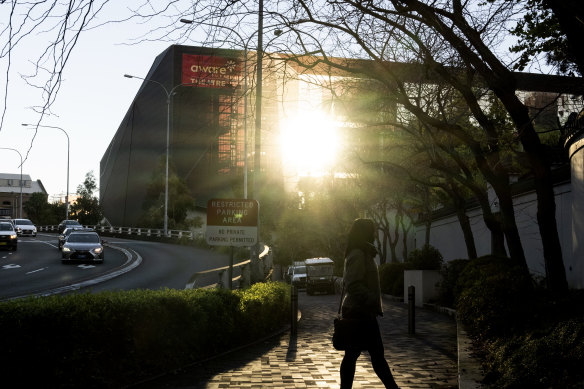By Julie Power
Australian drivers can expect to be blinded by the light in their morning and evening commute during the winter months, with some estimates of the risk of a crash rising 30 per cent.
That’s because sunrise and sunset in the months after the winter solstice coincides with Sydney’s peak hours, increasing the risk of sun glare causing collisions, says engineer Matt Glanville, a vice president with CPP Wind Engineering Consultants, who has worked on projects to mitigate reflected glare.

Early morning sun glare bouncing off the Aware Theatre building in Darling Harbour. The glare is prevented from falling on the road by a mesh awning on the side of the building. Credit: Louise Kennerley
In the United States, an estimated 8000 crashes a year are caused by sun glare.
A spokesperson for Transport for NSW said that since 1996, 45 people had died and 37 had been seriously injured in motor vehicle crashes in which glare was a factor. She said the numbers may be underreported.
Crashes increased 30 per cent during times of high sun glare, studies overseas have found. The Australian Road Safety Partnership says sun glare risk occurs when the sun hits a critical angle (20 degrees or less) during sunrise and sunset.
Last month, a Queensland driver pranged into a car when he was blinded to stopped traffic by a ball of sun in his direct line of sight just before 7am. And a report by the Australian Transport Safety Bureau found glare was a contributing factor in a helicopter crash near Cattai in NSW last July. Glare in the pilot’s line of sight meant he didn’t see a wedge-tailed eagle in time to avoid it. The pilot died from injuries caused by the crash.
Glanville said sun glare was more dangerous in winter because the sun is in a “low altitude blinding position” for longer throughout the day mid-winter. In summer, the sun rises much faster and was overhead for much of the day. And the risk was not as great in summer months because the worst glare happened when less traffic was on the roads.
“It’s a hazard multiplied by all the cars and traffic. If it is one car in a blue moon, it is not a huge risk, but the volume of traffic in peak hour makes it a real public risk,” he said.
With urbanisation, glare reflected by high-rise buildings was even worse because it was unexpected and unpredictable, often bouncing off glass facades and windows. Taller buildings reflect light over greater distances than shorter blocks.
In Sydney, buildings near major roads and highways have to mitigate this impact. To prevent reflective light bouncing off the glass exterior of the Aware Theatre in Darling Harbour, and into the eyes of motorists turning from Harbour Street in Haymarket along Pier Street, architects Hassell and Populous clad a corner of the building in a mesh.
Glanville said this solution reduced the risk from six times the acceptable level – about 3000 candelas a square metre – to below the threshold for luminance, which is 500 candelas per square metre. A candela is equivalent to the light emitted by a single candle.
On a walking tour to show other engineers the impact of glare, Glanville pointed out a building on Thomas Street, Ultimo, where its north-facing windows had been fitted with fins to prevent motorists turning right from Wattle Street from sudden blindness about 8am. “You turn this corner, and wham,” said Glanville.
How to reduce the risk of a glare-related crash
- Wear sunglasses.
- Clean the inside and outside surfaces of your windscreen regularly.
- Use sun strips to reduce glare that can impact peripheral vision.
- Drive to the conditions.
- Increase the distance between you and the car in front of you, slow down or take a break where it is safe and plausible to do so.
Source: Transport for NSW
The Morning Edition newsletter is our guide to the day’s most important and interesting stories, analysis and insights. Sign up here.